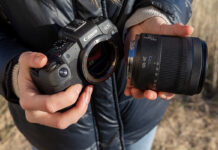
If you’re thinking of a smaller camera, Sony has one in the ZV-1F, a point-and-shoot model made to be simple to pull out and shoot with.
While it shares some similarities with the previous ZV-1 camera, the ZV-1F is more entry-level in just about every way. Rather than expand on what the previous camera could do, this one keeps everything very simple, and that means Sony cut out some features. It is a camera focusing as much on video as it does on still photos.

What you can expect with the Sony ZV-1F
This is a lightweight camera on par with a smartphone, weighing only 256 grams, and that includes an articulating LCD screen you can tilt and flip to view from just about any angle. It differs considerably from the ZV-1 in that it goes with a fixed focus 20mm prime lens instead of a more versatile 24-70mm lens. The wider field of view comes with an advantage in capturing more in every frame. If you’re shooting yourself or taking in a wider background, it’s the right kind of lens for that.
You can’t swap it out for another one, so what you see is what you get. It’s not as good at shooting objects up close, nor will it offer the same kind of bokeh effect when getting closer to a subject. A key thing to consider here is that the 20mm on paper is actually 25mm because the electronic image stabilization imposes a slight crop to keep things steady. The lens itself has no optical stabilization.

Inside, you’re shooting with a Type 1 20-megapixel BSI CMOS sensor capable of recording video in 4K up to 30fps, or 1080p HD up to 120fps for slow motion shots. The autofocus system is also different. Sony’s outstanding eye and face detection comes into play, but so does a less discerning contrast-detect focusing system. Phase detection autofocus are standard on most Sony cameras, including the ZV-1, but the ZV-1F will roll with a slower contrast-detect one.
It brings in the same “product showcase” feature the ZV-1 has, which adjusts focus when placing a person or object in front. There is a bokeh feature to bring in a blurry background when you need it. You don’t have to be a camera expert to figure it out, either. The camera can select the lowest aperture available based on the lighting you have to work with. It then maintains settings to keep the blur in the background.

Pairing with an app
To try and make the ZV-1F appealing for social media, it integrates with Sony’s smartphone app to transfer photos and video clips over quickly. Within the camera menu is an option called Shot Mark to shoot shorter clips of 15, 30, or 60 seconds, all of which fit perfectly with limits on apps like Instagram, TikTok, and Snapchat.
It also works as a livestreaming camera, albeit limited to 720p, when you connect it directly to a computer. Not bad if you want to use the camera in the field and then follow up with a live hit on your laptop. Slow and Quick Motion mode is back, where you can capture footage for timelapse and slow-motion clips. A Soft Skin Effect feature will smooth out skin a little more for either video or still photos.
The built-in microphone is directional, so it will pick up voices best when situated right in front of the camera. While it’s unclear how clear it actually would be in noisier or outdoor settings, you can use the included “dead cat” cover (the furry one) to cut down on wind noise.
Coming soon
The Sony ZV-1F is available for pre-order now. It comes in black or white and will be ready to go on October 24.



